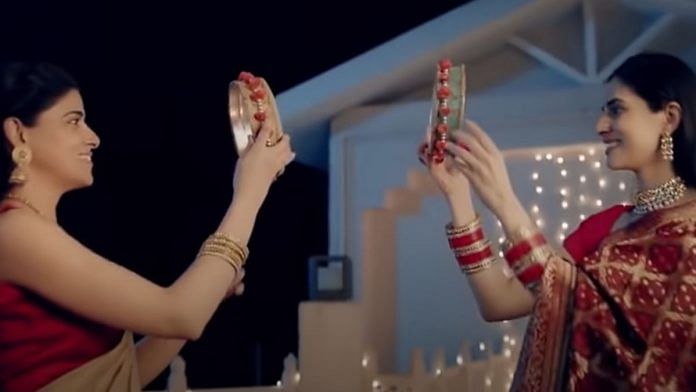Dabur Fem’s Karva Chauth ad has decided to toe the risky line between popular imagination and political message this year. It’s replete with longing for ‘glow’, long life for the lesbian partner and, of course, the mother-in-law. Naturally, the ad split the Red Sea that is social media.
The ad opens with the scene of two women discussing why they are fasting on Karva Chauth, when their mother-in-law appears with sarees for them so that they look like ‘chaand ka tukda’. It concludes with the reveal that both of them were observing the fast for each other as the narrator’s voice kicks in — ‘If this is the kind of glow you have, how can the world not change its thoughts? Fem. Glow with pride.’
When Simran from Dilwale Dulhania Le Jayenge feigned fainting so Raj could break her fast, the audience wooed. When, in Hum Dil De Chuke Sanam, Sameer reappeared as the “chhupa chaand”, the audience cheered. When in “Bole Chudiyan”, a feminine wave in red and gold collectively sang “Apni maang suhaagan ho, Sang hameshaa sajan ho (let our foreheads be always lined with wifedom, and our husbands stay on our side)” and likened their better halves to a resplendent moon, the audience chased it merrily. For Indians, much of Karva Chauth knowledge comes from the screen.
When the festival tip-toes around the corner, shopping centres are filled with hues of red, Hindi cinema billboards and Mehendi artists line up on the streets under Aishwarya Rai and Kajol banners. With most of the Hindi belt cities populated and influenced by Hindu-Punjabi communities, the opportunity for cinema and TV is golden — wives become the Simrans and husbands, the Rajs with a masculine ego as inflated as the moon’s diameter.
Also Read: Dropping ‘Fair’ from Fair & Lovely won’t erase Indian racism
Dabur Ad: an exercise in progress or opportunity?
Dabur’s ad seems to closely follow the trail of North Indian cinema and TV. The cities are dominated by Hindu-Punjabi factions, who not only harbour a vibrant liking for festivals on screen but are also known to hold an obsession with skin colour. For North Indians, bridal attire goes best with a complexion that “glows”, which is really a polite way of saying ‘fair’. Last year, Fair & Lovely made a similar move in rebranding to “Glow & Lovely”, receiving a lot of flak for the kind of message that it gave about skin tone and success. The fem ad is no different. It celebrates a lesbian couple during Karva Chauth, but hammers the fair-skin-looks-beautiful point home.
In that sense, like your average political armchair politician, Dabur decided to play on the popular LGBTQIA+ sentiment through appeasement politics, which is again a smokescreen for cashing in on a golden opportunity. Ever since Article 377 was abolished, which had virtually received zero recognition by brands earlier, political “wokeism” started making its way into popular dialogue. What was originally censored, became “lit.”
Dabur picked up on that and iced the cake with a rainbow flavour to present something new, in hopes of delighting the audience.
Also Read: Before Fair & Lovely, there was Afghan Snow — all about the fairness creams market in India
Move over the debate
It is unsurprising to see angry, bubbling debates on social media pointing fingers wherever seen fit. As much as it annoys, it also amuses with the sheer breadth of perspectives, which, when viewed from a political lens, is a welcome event. So long as there are human beings, there will be as many tongues who speak as many languages.
The point is, there is dialogue. Despite the “wokeism” that is ready to ram its bull’s horns wherever it sees red, the advertisement makes noise.
If Dabur could not delight with the Fem ad, it surely did let Indians loose on the political battleground. Indians were suddenly exposed to a barrage of questions, viewpoints, theories, comments and sentiments across the LGBTQIA+ spectrum. Politics, like human imagination, is a flavourful concept. It adapts, adjusts, and reshapes according to its time.
While the Fem ad surely did not score points on being politically correct with its undertones of skin-colour obsession, it allowed for a nuanced understanding of how politics functions — a surfacing of intersectionality — or politics that crosses between sex, race, and gender.
Where Indians were happy picking a single political thread and being progressive, the advertisement has led your next-door intellectual to be suddenly stopped in his tracks and told, “Hey, you know this isn’t right, right? It is lesbian, but also discriminatory!” For Indians now, though, perhaps political knowledge can come from the social media screen and that will have to suffice.
Views are personal.



